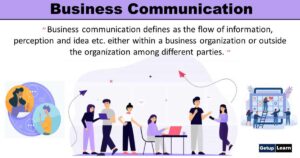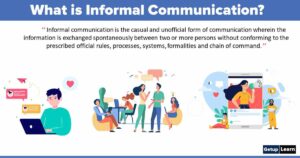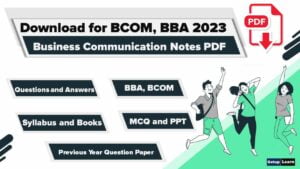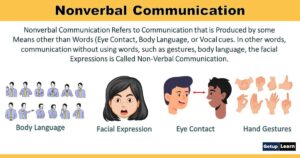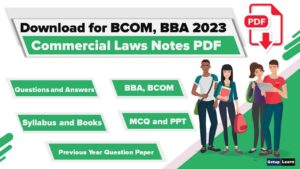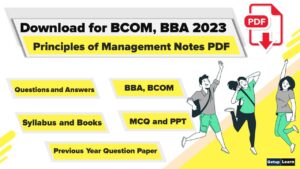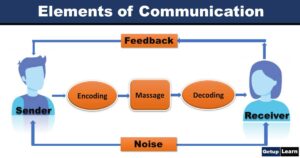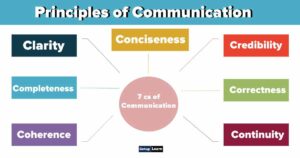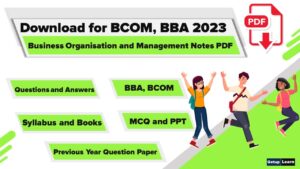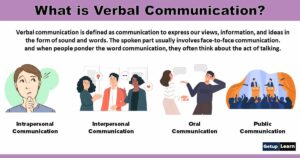Table of Contents
- 1 What is Group Discussion?
- 2 Features of Group Discussion
- 3 Elements of Group Discussion
- 4 Types of Group Discussion
- 5 Process of Group Discussion
- 6 Characteristics of Group Discussion
- 7 Roles in Group Discussion
- 8 Group Discussion Problems
-
9 FAQ Related to Group Discussion
- 9.1 What do you mean by a group discussion?
- 9.2 What are the features of group discussion?
- 9.3 What are the elements of group discussion?
- 9.4 What are the types of group discussions?
- 9.5 What is the process of group discussion?
- 9.6 What are the characteristics of group discussion?
- 9.7 Explain the group discussion problems.
What is Group Discussion?
Group discussion may be defined as a form of a systematic and purposeful oral process characterized by the formal and structured exchange of views on a particular topic, issue, problem, or situation for developing information and understanding essential for decision-making or problem-solving.

Group discussion is an important activity in academic, business, and administrative spheres. It is a systematic and purposeful interactive oral process. Here the exchange of ideas, thoughts, and feelings takes place through oral communication.
The exchange of ideas takes place in a systematic and structured way. The participants sit facing each other almost in a semi-circle and express their views on the given topic/issue/problem.
“Group” is a collection of individuals who have regular contact and frequent interaction and who work together to achieve a common set of goals. “Discussion” is the process whereby two or more people exchange information or ideas in a face-to-face situation to achieve a goal.
The goal, or end product, may be increased knowledge, agreement leading to action, disagreement leading to competition or resolution, or perhaps only a clearing of the air or a continuation of the status quo.
Read Also: What is Group Communication?
Features of Group Discussion
For any group discussion to be successful, achieving group goals is essential. The following features of group discussion:
- Having a Clear Objective
- Motivated Interaction
- Logical Presentation
- Cordial Atmosphere
- Effective Communication skills
- Participation by all Candidates
- Leadership Skills
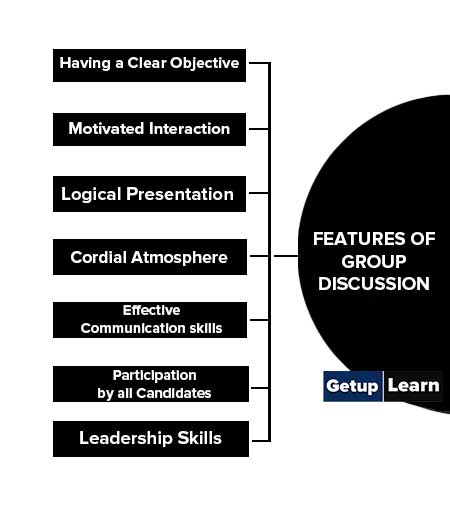
Having a Clear Objective
The participants need to know the purpose of the group discussion so that they can concentrate during the discussion and contribute to achieving the group goal. An effective group discussion typically begins with a purpose stated by the initiator.
Motivated Interaction
When there is a good level of motivation among the members, they learn to subordinate their personal interests to the group interest and the discussions are more fruitful.
Logical Presentation
Participants decide how they will organize the presentation of individual views, how an exchange of the views will take place, and how they will reach a group consensus. If the mode of interaction is not decided, few of the members in the group may dominate the discussion and thus will make the entire process meaningless.
Cordial Atmosphere
The development of a cooperative, friendly, and cordial atmosphere avoids confrontation between the group members.
Effective Communication skills
The success of a group discussion depends on the effective use of communication techniques. Like any other oral communication, clear pronunciations, simple language, and the right pitch are the prerequisites of a group discussion. Non-verbal communication has to be paid attention to since means like body language convey a lot in any communication.
Participation by all Candidates
When all the members participate, the group discussion becomes effective. Members need to encourage each other in the group discussion.
Leadership Skills
Qualities like initiation, logical presentation, encouraging all the group members to participate, and summarizing the discussion reflect leadership qualities.
Read Also: Importance of Group Communication
Elements of Group Discussion
These are the elements of group discussion:
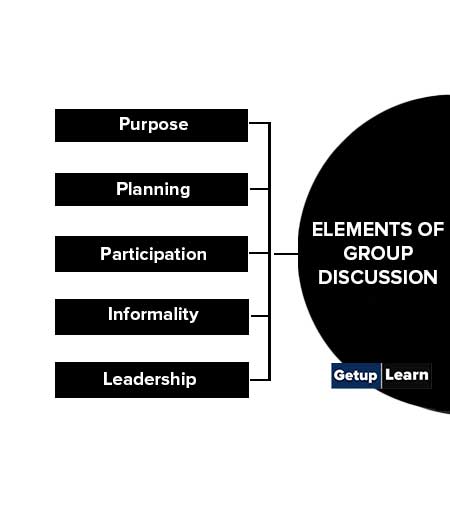
Purpose
There can be a fruitful discussion without a clear purpose aimless talking is not discussion and no organization and no organization can afford to waste its precious time in aimless talking. Without a clearly stated purpose, the participants are likely to skip from one topic to another.
Following are the purposes of group discussion:
- Your communication skills.
- How do you respond to different situations and your ability to think on your feet?
- Your ability to analyze topics.
- Your knowledge of different subjects.
- Your group dynamics and team skills.
Planning
A group cannot rely on the random or on-the-spot expression of feelings and ideas. Advance planning is necessary. The agenda, the notice to members, date, time, and venue of the discussion need to be decided carefully. A meaningful discussion can take place only after careful thought is given to what is to be discussed.
Participation
In the group discussion, each individual member is expected to participate and contribute to the deliberation of the group. Members who do not speak in discussion participate through active listening. A meaningful and effective discussion is impossible without participation.
If few persons dominate the discussion rest of the members become passive listeners.
Informality
In a discussion, the members should be made to feel comfortable and at ease to speak. An informal and cordial atmosphere encourages the fullest possible participation in the discussion, though group discussion is formal.
Leadership
A good is essential for a group discussion. The leader initiates and pilots the discussion steering through all troubles. In the absence of a leader, the discussion may run haywire, and the group might become chaotic.
Read Also: Advantages of Group Communication
Types of Group Discussion
Let’s look at the types of group discussion:
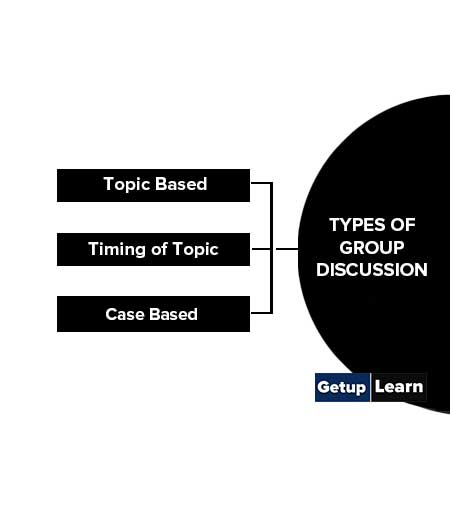
Topic Based
In this kind of group discussion, participants are expected to discuss a given topic. Many times, especially in the case of the job selection process, participants are given multiple topics and the group can choose any one of them to discuss further. The choice of the final topic is based on the consensus among the group members. A topic for discussion varies from factual to abstract.
Timing of Topic
The topic for group discussion could be announced either before the date of discussion or on the spot. Pre-announced topics give an opportunity to participants to prepare for discussion while on spot topic checks the presence of mind of the participants. In an on-spot situation, participants are given five to ten minutes to arrange their thoughts.
Case Based
Sometimes the participants are given a case to discuss upon. The case could be from a real-life situation or a hypothetical one. At the end of the case, a few questions are posed to the participants. All the participants are expected to analyze the case properly and provide the most logical and innovative solution to the question.
Read Also: Characteristics of Group Communication
Process of Group Discussion
These are the steps of the process of group discussion:
- Know the Purpose
- Decide Group Members
- Seating Arrangements
- Give Necessary Instructions
- Announcement of Topic
- Discussion Time
- Assessment
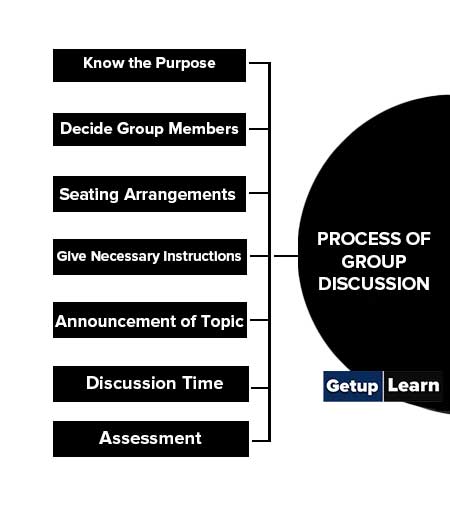
Know the Purpose
Before conducting a group discussion its purpose must be clear to everyone. A purpose could act as a guiding force that can keep the discussion on track. A purpose could also provide a basis for evaluating the effectiveness of the discussion. The purpose for discussion could range from discussing the applicability of a strategy to the selection of a suitable candidate.
Decide Group Members
In case many participants are there, they need to be divided into smaller groups. So, the next decision is about the number of participants in a group and the number of groups. As suggested earlier, eight to fifteen members per group make it ideal for discussion.
Seating Arrangements
In order to provide a suitable environment for discussion, proper seating arrangements need to be made. A good seating arrangement helps the participants to communicate effectively. As a rule, every member of the group must be in a position to look at and communicate with all the other members of the group. The popular seating arrangement styles are circular and semi-circular styles.
Give Necessary Instructions
The role of a moderator is to announce necessary instructions prior to the commencement of the discussion. These instructions are given to ensure the smooth conduct of the discussion. Instructions could be related to the time limit for discussion, general rules of conduct, etc.
Announcement of Topic
Now is the time to announce the topic or provide the case for discussion. Generally, at this stage few minutes are provided to the participants to organize their thought. Permission to use pen and paper varies from moderator to moderator.
Discussion Time
At this stage, the moderator gives permission to start the discussion. All the participants try to present their viewpoints with supportive arguments on the given topic. One of the members generally initiates the discussion and others start pouring in their views and so on.
Unless and until mutually decided, no particular sequence is followed to present the views. At the conclusion stage, one of the members takes initiative to summarize the discussion in the light of the purpose.
Assessment
Once the discussion is over the judges evaluate the performance of each member on pre-decided criteria. Such evaluation criteria might include group behavior, communication skills, leadership qualities, analytical skills, subject knowledge, etc.
Characteristics of Group Discussion
Characteristics of group discussion are explained below:
- Having a Clear Objective
- Motivated Interaction
- Logical Presentation
- Cordial Atmosphere
- Effective Communication Skills
- Participation by All Candidates
- Leadership Skills

Having a Clear Objective
The participants need to know the purpose of the group discussion so that they can concentrate during the discussion and contribute to achieving the group goal. An effective group discussion typically begins with a purpose stated by the initiator.
Motivated Interaction
When there is a good level of motivation among the members, they learn to subordinate their personal interests to the group interest and the discussions are more fruitful.
Logical Presentation
Participants decide how they will organize the presentation of individual views, how an exchange of the views will take place, and how they will reach a group consensus. If the mode of interaction is not decided, a few of the members in the group may dominate the discussion and thus will make the entire process meaningless.
Cordial Atmosphere
The development of a cooperative, friendly, and cordial atmosphere avoids confrontation between the group members.
Effective Communication Skills
The success of a group discussion depends on the effective use of communication techniques. Like any other oral communication, clear pronunciation, simple language, and the right pitch are the prerequisites of a group discussion. Non-verbal communication has to be paid attention to since means like body language convey a lot in any communication.
Participation by All Candidates
When all the members participate, the group discussion becomes effective. Members need to encourage each other in the group discussion.
Leadership Skills
Qualities like initiation, logical presentation, encouraging all the group members to participate, and summarizing the discussion reflect leadership qualities.
Continue Your Reading: Characteristics of Group Communication
Roles in Group Discussion
At the time of commencement of a group discussion, all the members are on par with each other. Still, all the members assume different roles at different stages during the discussion. The choice of the role assumed by an individual depends upon his/her personal characteristics.
In addition to it, sometimes a member plays more than one role during the discussion. Following is the list of some roles in group discussion:
-
Starter: This member initiates the discussion and set the tone for further discussion.
-
Connector: This member tries to connect the ideas of all the members of the group.
-
Extender: This member extends the viewpoints presented by the previous speaker by adding more information.
-
Encourager: This member ensures that all other members are actively participating in the discussion.
-
Critic: A critic always provides a significant analysis of the presented idea.
-
Peacemaker: If a situation arises where the members of the group are locking horns with each other, this member tries to pacify them to ensure a harmonious discussion.
- Tracker: A tracker keeps the discussion on track and prevents it from going haywire.
Group Discussion Problems
A dialogue between two persons suffers from several barriers. When the number of people increases, there are additional emotional filters, listening inefficiencies, and other problems. Some of the problems involved in group communication are:
- Physical Arrangements
- Visual Aids
- Group Structure
- Organization of Discussion Material
- Notice to Participants
- Conduct of Discussion
- Follow Up
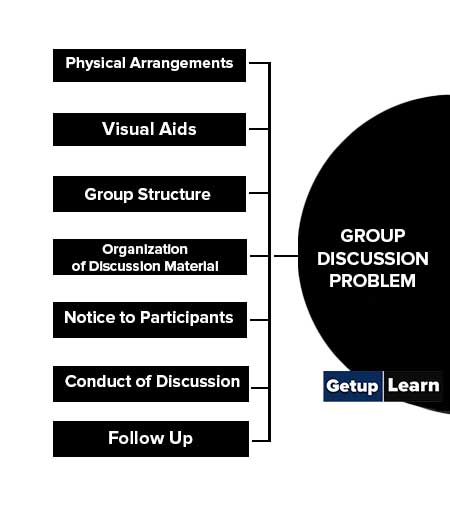
Physical Arrangements
The furniture and another physical arrangement for a group discussion should be such that a speaker faces other participants and can maintain eye contact. Each type of discussion group may require a different type of seating arrangement. The room in which the discussion is held should be well-lighted, Well ventilated, and free from noise. Adequate stationery and other material should be provided to the participants.
Visual Aids
When the topic of discussion requires consideration of figures and project plans, charts, maps, slides, and other visual aids should be provided to assist the flow of ideas.
Group Structure
Generally, a homogeneous group can Indulge better in the discussion. Mixed groups do not communicate easily. However, all shades of opinion should be represented in the discussion. Members of the group should be selected to ensure a smooth flow of information. The topic of discussion should be within the experience and competence of the group.
Organization of Discussion Material
The group must know the topic and purpose of the discussion. The scope of the discussion has to be restricted to the time allotted. The discussion sequence (a series of questions to be discussed) must be tentatively planned in advance.
Notice to Participants
The persons who are to participate in the discussion should be given sufficient time to think over the topic and collect the necessary data and other materials which they want to use in the discussion.
Conduct of Discussion
The leader will open the discussion by stating its topic and purpose. He should allow reasonable opportunities for the participants to speak and answer questions. At the end of the discussion, he should summarise the main points of discussion and the conclusions arrived at. Finally, he should thank the members for their contributions to the discussion.
Follow Up
After the discussion, it is necessary to write down the conclusions. A copy may be sent to every participant and other concerned persons. It may be necessary to send notices, letters, etc. to persons who are required to take action on the basis of conclusions arrived in a discussion.
Read More Related Articles
[su_spoiler title=”What is Communication? | Mass Communication” style=”fancy” icon=”plus-circle”]
What is Communication?
[/su_spoiler]
[su_spoiler title=”Types of Communication | Principles of Communication” style=”fancy” icon=”plus-circle”]
-
Types of Communication
- Verbal Communication
- Non-Verbal Communication
- Written Communication
- Visual Communication
- Feedback Communication
- Mass Communication
- Group Communication
[/su_spoiler]
[su_spoiler title=”Nonverbal Communication | Verbal Communication” style=”fancy” icon=”plus-circle”]
[/su_spoiler]
[su_spoiler title=”Written Communication | Oral Communication” style=”fancy” icon=”plus-circle”]
Written Communication
[/su_spoiler]
[su_spoiler title=”Business Communication | Organizational Communication” style=”fancy” icon=”plus-circle”]
[/su_spoiler]
[su_spoiler title=”Formal Communication | Informal Communication” style=”fancy” icon=”plus-circle”]
[/su_spoiler]
[su_spoiler title=”Interpersonal Communication | Informal Communication” style=”fancy” icon=”plus-circle”]
[/su_spoiler]
[su_spoiler title=”Downward Communication | Upward Communication” style=”fancy” icon=”plus-circle”]
[/su_spoiler]
[su_spoiler title=”Barriers to Communication | Horizontal or Lateral Communication” style=”fancy” icon=”plus-circle”]
[/su_spoiler]
[su_spoiler title=”Self Development | Effective Communication” style=”fancy” icon=”plus-circle”]
[/su_spoiler]
[su_spoiler title=”Difference Between Oral and Written Communication | Theories of Communication” style=”fancy” icon=”plus-circle”]
[/su_spoiler]
What do you mean by a group discussion?
Group discussion may be defined as a form of a systematic and purposeful oral process characterized by the formal and structured exchange of views on a particular topic, issue, problem, or situation for developing information and understanding essential for decision-making or problem-solving.
What are the features of group discussion?
Features of group discussion are given below:
1. Having a Clear Objective
2. Motivated Interaction
3. Logical Presentation
4. Cordial Atmosphere
5. Effective Communication skills
6. Participation by all Candidates
7. Leadership Skills.
What are the elements of group discussion?
Elements of group discussion are given below:
1. Purpose
2. Planning
3. Participation
4. Informality
5. Leadership.
What are the types of group discussions?
These are three types of group discussion:
1. Topic Based
2. Timing of Topic
3. Case Based.
What is the process of group discussion?
Processes of group discussion is the given below:
1. Know the Purpose
2. Decide Group Members
3. Seating Arrangements
4. Give Necessary Instructions
5. Announcement of Topic
6. Discussion Time
7. Assessment.
What are the characteristics of group discussion?
Characteristics of group discussion are given below:
1. Having a Clear Objective
2. Motivated Interaction
3. Logical Presentation
4. Cordial Atmosphere
5. Effective Communication Skills
6. Participation by All Candidates
7. Leadership Skills.
Explain the group discussion problems.
These are the group discussion problems:
1. Physical Arrangements
2. Visual Aids
3. Group Structure
4. Organization of Discussion Material
5. Notice to Participants
6. Conduct of Discussion
7. Follow Up.


